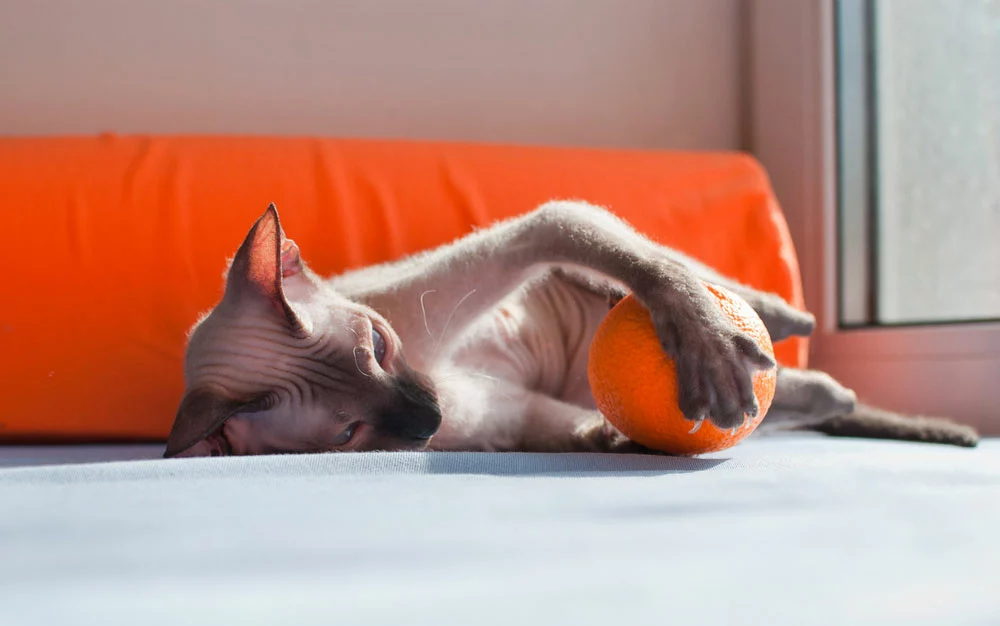Cats are a popular choice for pets, with almost 25 percent of American households having them. But cats are mischievous. As a result, they may wander to specific regions that are out of bounds destroying items or plants. Also, cat waste can contain pathogens that are harmful to humans.
You may have tried several repellents but with little success. Use orange peels if you don’t want cats roaming in your garden or yard. But do orange peels keep cats away?
Read on to find out.
Table of Contents
- Why Do Orange Peels Repel Cats?
- How To Make A Cat Repellent Using Orange Peels?
- Pros & Cons Of Using Orange Peels For Making A Cat Repellent
- Alternatives To Orange Peels For Making A Cat Repellent
- Conclusion
Why Do Orange Peels Repel Cats?

(Sphynx cat playing with orange)
Citrus fruits have a powerful aroma that’s appealing to humans but not to your cat’s sensitive nose. However, by nature, cats will always detest most citrus fruits, including limes, lemons, and oranges. Additionally, their dislike of citrus fruits is a defense mechanism that prevents them from eating orange peels.
How To Make A Cat Repellent Using Orange Peels?

(A cat and a basket of vegetables)
Method 1: Directly Throw The Peels In The Periphery Of Your Garden
Cats have exceptionally sensitive noses and can detect odors from a greater distance than humans. Additionally, most cats dislike the smell found in oranges.
Place orange peels strategically to prevent cats from invading and messing up your garden. Strategic places include areas where cats love playing on, fences, walls, or even under garden trees.
If you want to keep cats away from your garden, cut the orange peels into small pieces and spread them around.
It would be best if you replaced the peels regularly to keep the orange smell sufficiently repulsive for repeat visitors. Unfortunately, doing so is tedious and may be impractical on a wide scale.
Method 2: Make A Cat Repellent Spray Using The Orange Peels

(Kitten near a fruit basket)
Ingredients
- Orange peels (from 3 to 4 oranges)
- 150 mL of water
- Spray bottle
- Funnel
Step 1: Add two cups of clean water to a medium pot. Place the pot over medium-high to high heat for 5 to 7 minutes until the water reaches its boiling point.
Step 2: Add orange peels to the hot water, and let the mixture simmer for 15 to 20 minutes. Just ensure that you lower the heat once you notice the mixture boiling.
Step 3: Take the pot off the heat source, and let the mixture sit at room temperature for 30 minutes. When it is cold, strain the orange peels before transferring the resultant liquid to a spray bottle.
Step 4: Spray the orange peels cat repellent in the areas that you’ve identified are popular with cats.
Pros & Cons Of Using Orange Peels For Making A Cat Repellent

(Orange peels on a light blue wooden table)
Pros
- Using orange peels is a safe method that won’t endanger the lives of your cats or other animals.
- In addition to repelling cats, orange peels cat repellent spray may serve as an air freshener. It is more so when you use it inside your kitchen, dining room, or even a closed balcony.
Cons
- Orange peels are organic and sensitive to weather elements, including rain and sunshine. The peels will dry quickly on a sunny day, whereas rain washes away the citrus smell.
- If your cat eats orange peels, it may display symptoms including weakness, acid reflux, drooling, vomiting, and diarrhea. Thankfully, this condition seldom results in death.
- The orange smell isn’t strong and will only work effectively in a localized area. If you have a large garden, chances are that you’ll have to use a lot of orange peels to get sufficient repellents.
- On a large scale, organic repellents will be costlier than inorganic alternatives.
Alternatives To Orange Peels For Making A Cat Repellent
(A playful cute kitten)
Here are some excellent options if you don’t like using orange peels as cat repellents.
Scent-Based Cat Repellents
- Coffee grounds
- Lavender
- Lemons
- Rosemary
- Vinegar
Motion-Activated Sprinkler System
If you want a mechanical repellent, you can opt for the motion-activated sprinkler system. The system employs a motion sensor to find most pests’ body positions, including cats. When activated, it releases a burst of water together with sudden noise and motion to act as a safe and powerful deterrent.
Conclusion
It would be best never to allow your cat to eat an orange or orange peel. Unlike humans, cats lack the mechanism to metabolize essential oils, including linalool, limonene, and psoralens, present in citrus fruits.
Consequently, be careful if you’ve decided to go with orange peel repellents. We recommend using orange peel repellent spray for internal spaces and orange peels for food gardens.
